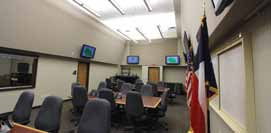Adding new monitors is easy, thanks to the hub-and-spoke distribution architecture. If the Williamson County EOC team needs to add new monitors, they can add new coaxial lines from the MediaManifold RF amplifier, or add more sources using Contemporary Research QMOD HDTV modulators. In the age of advanced IP networking, a basic bidirectional cable TV system seems an unlikely backbone for a modern Emergency Operations Center (EOC). But cable TV has proven to be a life-saver for the new $18 million Williamson County EOC in Georgetown, Texas. Tasked with handling the region’s regular 911 dispatch services, plus expanded EOC duties during tornadoes and other disasters, the Williamson EOC’s cutting-edge capabilities are based on its cable TV infrastructure — rather than in spite of it.
A History of Occasional Emergencies
Located in central Texas, Williamson County has experienced its share of major emergencies and disasters. They include the 1997 F5 Jarrell Tornado, 1998 Amtrak train derailment, 1999 Liberty Hill pipeline explosion, 2008 and 2011 wildfires, 2005/2008’s Hurricanes Katrina, Rita, and Ike evacuee shelter operations, and numerous flash floods — the latest being from 2010’s Tropical Storm Hermine.
“In each of those disasters, local emergency responders were forced to work in cramped facilities and makeshift operation centers,” according to an online report at www.HillCountryNews.com. “At one point, Williamson County Emergency Services Director John Sneed remembers emergency responders being forced to meet in a refurbished Capital Metro bus because that was the only conference space available.”
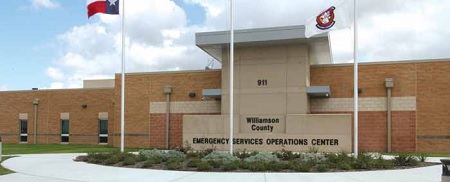
Officially opened in October 2013, the new 30,000-square foot EOC is a response to this problem. Its main control center is a 20-by-40-foot 911 Dispatch Center that normally has 20 people on duty in various roles. When trouble hits, an expanded EOC room next door to 911 Dispatch can be added into the mix, with enough space for 75 more people. The EOC is strong enough to withstand 150 mph winds — tornadoes being an ongoing threat in this part of Texas — has a backup generator and a 5,000-gallon water tank.
A Sophisticated Facility
Audiovisual equipment is central to the Williamson County EOC’s capabilities. The people here need to be able to see and share video being brought in from incident scenes, via their own vehicle-mounted, mast-mounted and/or CCTV security cameras. The staff also needs access to weather and broadcast information from Time Warner cable TV and local over-the- air TV signals, visuals from the County’s CAD, discrete feeds from the 32 workstations as required, internal EOC briefings.
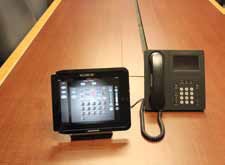
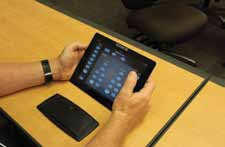
Using an iPad-based control system, EOC staff at the Williamson Country Center can punch up the audio/feeds they need: be it broadcast, cable, or
one of the 16 PC-accessible channels provisioned on the system. The result is as flexible and capable as a two-way system, but less expensive to build and provision.
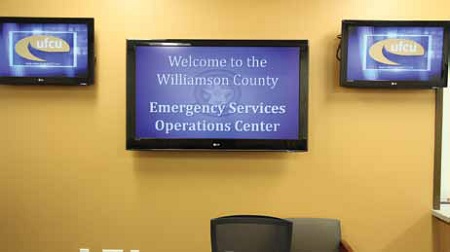

In a typical solution, the EOC would supply these signals using an IPTV or twisted-pair video routing system. But Williamson County only had $6 million to build its EOC infrastructure. That’s why it decided to use an RF-based digital cable system instead.
“By setting up our own in-house cable TV network, we are able to serve all of the channels we need to 66 commercial-grade TVs installed around the EOC,” says Jarred Thomas, the EOC’s Emergency Management Coordinator. “Using an iPad-based control system, EOC staff can punch up the audio/feeds they need; be it broadcast, cable, or one of the 16 PC-accessible channels provisioned on the system. The result is as flexible and capable as a two-way system, but less expensive to build and provision.
The Williamson County EOC was designed by Shen Milsom Wilke, LLC., of Houston, Texas. The integration was done by Ford Audio-Video (also of Houston), under Shen Milsom Wilke’s direction.
The Nitty-Gritty
The heart of “EOC Cable TV” is housed in the EOC’s Master Distribution Room. It employs Contemporary Research QMOD HDTV encoder modulators to distribute 30 cable programs and 16 PCs as high-definition in-house cable channels. Crestron Media Manifold RF amplifiers are used to power the signal to the site’s TVs. A Contemporary Research ICE-HE control modulator send commands to CR’s TV controllers to enable an integrated control and video system over the RF coax network.
“Conventional cable TV drops suffer from signal losses and other issues,” said Jim McConnell, a Senior Associate with Shen Milsom Wilke. “The hub-and-spoke model we use, with direct feeds from one end to another, ensure consistent signal levels for every single user.”
At the user end, the Williamson County EOC staff employ iPads loaded with the Crestron Mobile Pro Control App for mobile devices. Compatible with both Android and Apple devices, this app allows users to manage all elements of their AV system by smartphone or tablet. In this instance, the iPad-based control units show icons representing the major broadcast networks, PC inputs 1-16, TV volume and room volume.
‘We chose the iPad as a control platform both because people are familiar with, and one that is less expensive for us to buy and replace than any proprietary unit,” Thomas says. “We’ve found that our staff are very comfortable with it.”
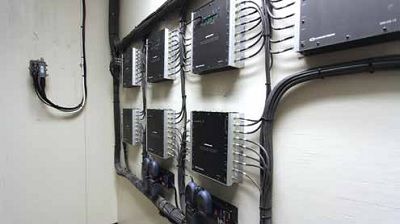
The cable TV model is well-suited to the EOC’s needs, and lets the team select the portfolio of signals that they want to distribute around the facility. It also lets them create a central distribution system that is entirely under their
control and maintenance.

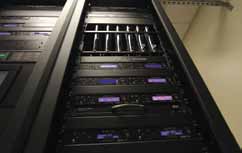
Ford Audio-Video melded Contemporary Research’s ICC1-232, RS 232 TV controller and SW-DX Display Express Software with the Crestron control system to provide cost-effective display control. “With a small, customizable application running on their PC, Williamson County staff can control the numerous displays throughout the building,” said McConnell. “Command signals are carried over the RF distribution cabling so only one cable is required at each display for TV and control. Universal commands can ensure that all displays are turned off at the end of a normal work day to reduce energy and lengthen the life of the display.”
An Affordable Solution
The decision to install QMOD HDTV modulators and controllers, combined with Crestron MediaManifold and Mobile Pro Control App was a bit of an envelope-pusher. “This is fairly new technology,” says Ron Waltisperger, Ford Audio- Video’s Project Manager. “So we felt we were taking a bit of a risk, but the truth is that it has worked well since Day One.”

Command signals are carried over the RF distribution cabling so only one cable is required at each display for TV and control. Universal commands can ensure that all displays are turned off at the end of a normal work day to reduce energy and lengthen the life of the display.It is early days for the Williamson County EOC, but already the value of the cable TV solution appears to be proving itself.
“The cable TV model is actually quite well-suited to our needs,” says Jarred Thomas. “It lets us select the portfolio of signals that we want to distribute around our facility, and put them into a central distribution system that is entirely under our control and maintenance. It also lets us decide what kind of new signals need to be added on an as-needed basis; from external sources, in-house, or even from one of our workstations.”
“The ability to control the feed selection at each TV provides the level of control that our customers need,” says Jim McConnell. “Yet we are able to provide this without having to set up an IP-based system and the software to run it, plus carriage on an IP network.”

The cable-TV distribution model has given the Williamson County EOC a new level of control.

The bottom line: Using a cable TV distribution model has allowed Williamson County to access a level of cutting-edge suite of on demand AV signals, on a cost-effective basis. For other agencies seeking to provide similar services on a budget, ‘EOC Cable TV’ could be a good option.
James Careless is a frequent contributor to NewBay Media’s AV Technology and Digital Video.
info
CRESTRON
crestron.com
CONTEMPORARY RESEARCH
contemporaryresearch.com
